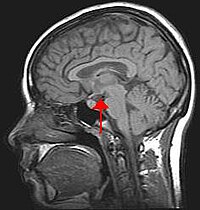
Photo from wikipedia
In this paper, we use a model modified from classic corticothalamic network(CT) to explore the mechanism of absence seizures appearing on specific relay nuclei (SRN) of the thalamus. It is… Click to show full abstract
In this paper, we use a model modified from classic corticothalamic network(CT) to explore the mechanism of absence seizures appearing on specific relay nuclei (SRN) of the thalamus. It is found that typical seizure states appear on SRN through tuning several critical connection strengths in the model. In view of previous experimental and theoretical works which were mainly on epilepsy seizure phenomena appearing on excitatory pyramidal neurons (EPN) of the cortex, this is a novel model to consider the seizure observed on thalamus. In particular, the onset mechanism is different from previous theoretical studies. Inspired by some previous clinical and experimental studies, we employ the external stimuli voltage on EPN and SRN in the network, and observe that the seizure can be well inhibited by tuning the stimulus intensity appropriately. We further explore the effect of the signal transmission delays on seizures, and found that the polyspike phenomenon appears only when the delay is sufficiently large. The experimental data also confirmed our model. Since there is a complex network in the brain and all organizations are interacting closely with each other, the results obtained in this paper provide not only biological insights into the regulatory mechanisms but also a reference for the prevention and treatment of epilepsy in future.
Journal Title: Scientific Reports
Year Published: 2018
Link to full text (if available)
Share on Social Media: Sign Up to like & get
recommendations!